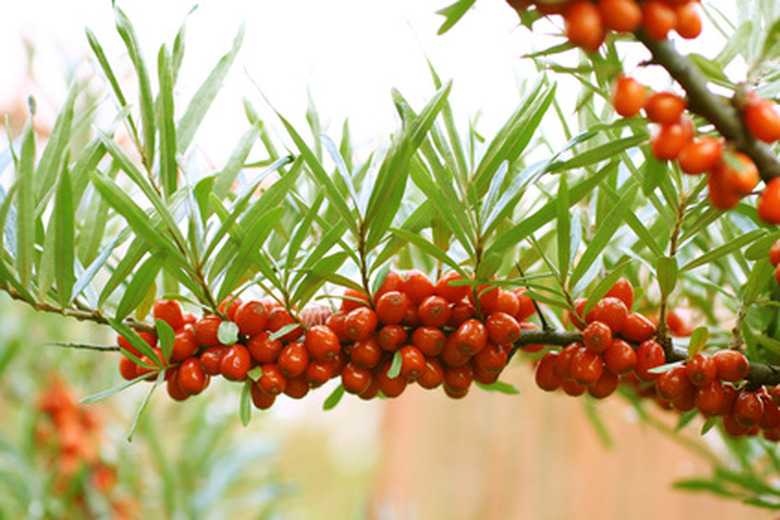How To Propagate Buckthorn
Things Needed
- Buckthorn cuttings
- Jar
- Water
- Sterilized potting soil
- Perlite
- Rooting hormone powder
- Misting bottle
- Spade or rototiller
- Organic manure
Sea Buckthorn is a relative newcomer to the U.S., but it is making a big splash. The plant itself is a fast-growing cross between a tree and a shrub, grows to approximately 6 to 12 feet tall, and has silvery leaves. Buckthorn produces a red berry which is extremely high in many vitamins, including vitamin C, and is comprised of approximately 30% usable protein. The berries are harvested late in the season, approximately 25 days before the first frost in your particular area. Buckthorn grows well in hardiness zones 3 through 8, and does best in sandy loam with plenty of organic matter mixed in. Buckthorn propagated by cuttings is absolutely true to the parent plant (which is not necessarily true of seed reproduction), and buckthorn propagated with cuttings produce berries one to two years sooner than plants grown from seeds.
Propagation by Hardwood Cuttings
Step 1
Take cuttings from last year's growth that have a thick, woody growth of bark. Take them in the late fall or very early spring, before the plants show any signs of life. Cuttings should be approximately 6 to 8 inches long. Cuttings can be stored for several weeks in a cool, dry location.
- Sea Buckthorn is a relative newcomer to the U.S., but it is making a big splash.
- The plant itself is a fast-growing cross between a tree and a shrub, grows to approximately 6 to 12 feet tall, and has silvery leaves.
Step 2
Place bundles of hardwood cuttings, with their cut end down, in a jar approximately 4 to 5 inches deep and fill with room-temperature water. Keep in a sunny location, out of direct sunlight, and keep cuttings warm (65 to 70 degrees F). Change water daily.
Step 3
Roots should appear within 7 to 10 days. Transplant to growing pots filled with sterilized potting soil. Allow pots to receive at least 4 hours of direct sun per day. Transplant outdoors to a sandy loam soil mixed with organic manure after the plants have been growing indoors for 60 days.
- Place bundles of hardwood cuttings, with their cut end down, in a jar approximately 4 to 5 inches deep and fill with room-temperature water.
- Transplant outdoors to a sandy loam soil mixed with organic manure after the plants have been growing indoors for 60 days.
Propagation by Softwood Cuttings
Step 1
Take softwood cuttings that are approximately 6 to 8 inches in length from a buckthorn tree. Softwood is this year's growth, and is a branch tip cutting taken in midsummer, before the wood has become hard. Cut just below a leaf node.
Step 2
Remove all of the lower leaves, leaving only one or two leaves at the tip of the cut branch.
Step 3
Fill a growing pot with damp perlite and make a 3-inch deep hole in the perlite with a pencil or your finger. Dip the cut end of the cutting into rooting hormone powder, then carefully push it into the hole you made in the perlite. Gently press the damp perlite around the cutting.
- Take softwood cuttings that are approximately 6 to 8 inches in length from a buckthorn tree.
- Dip the cut end of the cutting into rooting hormone powder, then carefully push it into the hole you made in the perlite.
Step 4
Place the growing pot in a well-lit room, allowing the plant to receive direct sunlight for approximately 4 hours each day. Mist the cuttings frequently with water to keep them moist. Your cuttings should be ready to transplant outdoors in 30 to 60 days.
Step 5
Prepare a sunny, well-drained location for your buckthorn by turning the soil with a spade or rototiller, mixing organic manure into the soil in an approximately 50/50 mixture.
Tip
Do not plant outdoors until the danger of frost has passed.
